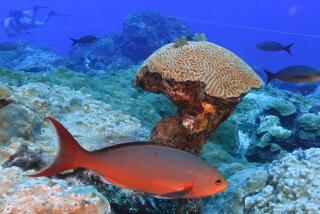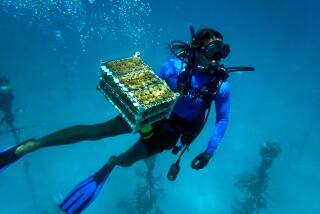Scientists discover coral reef near the mouth of the Amazon River
- Share via
Scientists have discovered vibrant coral reef ecosystem near the mouth of the Amazon River that stretches roughly 3,700 square miles -- even though coral isn’t supposed to be able to grow there in the first place.
The reef described in the journal Science Advances could shed light on how these delicate organisms, which provide essential scaffolding for so much marine wildlife, might survive in less-than-ideal conditions.
Coral are tiny little soft-bodied animals, related to anemones and to jellyfish, that band together to build their protective, rock-like reefs by pulling calcium and carbonate out of the ocean water. Reefs serve as hot spots of biodiversity, home to a vast array of sea creatures, from crabs, sea urchins and algae to fish, sharks and turtles.
Coral reefs thrive in clear waters along tropical shelves, but river systems like the Amazon are thought to create gaps where they do not grow. That’s in part because the plume of murky, sediment-filled water spilling out from the gargantuan river and into the ocean doesn’t allow much light to come through.
So the discovery came as a total surprise to study coauthor Patricia Yager, an oceanographer at the University of Georgia, who in 2012 set out with Brazilian scientists aboard the research vessel Atlantis to study the plume coming out from the river mouth and flowing into the ocean.
But one of the researchers on board, Rodrigo Moura of the Federal University of Rio de Janeiro, showed her a paper from the 1970s that indicated that reef fish had been caught near the continental shelf. He and another researcher were interested in following up this lead by looking for coral reefs in the river mouth.
“I kind of looked at him like he was crazy, thinking, ‘You know how muddy it is there -- how could there possibly be a reef there?’” Yager recalled.
But Yager isn’t a reef specialist, so she shrugged and got him some needed equipment. During the cruise Moura began pinging the seafloor using an acoustic detector, pointing out spots that he thought might be coral. Later, in a spot that looked promising, Moura ran a dredge through the water to gather samples — and hit the jackpot.
“Unbelievably, he brought up onboard the deck just the most amazing things I’d ever seen ... beautiful, colorful reef animals that I had no idea were down there,” Yager said.
The Brazilian team returned on another boat in 2014 and gathered more samples, ultimately discovering an abundance of corals, sponges, brittle stars and reef fish, among others.
These reefs might serve as steppingstones between the Brazil reefs and the Caribbean reefs and might serve as a temporary refuge for some of the animals that live between them, Yager said. They might also reveal how coral reefs survive in less than optimal conditions – and thus might offer insight into how reefs behave in the future, as the oceans become increasingly unfriendly to them. Coral reefs around the world are under threat as ocean temperatures and acidity levels rise thanks in large part to human activity.
There’s a certain amount of irony in the discovery, as the system is already under threat from oil drilling and high levels of fishing in the area, the scientists said.
“Isn’t that always the case — you don’t know what you’ve got until it’s gone?” Yager said.
The scientists pointed out that, in light of this discovery, assessments of environmental impact would be out of date.
“In the past decade, a total of 80 exploratory blocks have been acquired for oil drilling in the study region, 20 of which are already producing,” the study authors wrote. “These blocks will soon be producing oil in close proximity to the reefs, but the environmental baseline compiled by the companies and the Brazilian government is still incipient and largely based on sparse museum specimens.
“Such large-scale industrial activities present a major environmental challenge,” they added, “and companies should catalyze a more complete social-ecological assessment of the system before impacts become extensive and conflicts among the stakeholders escalate.”
Follow @aminawrite on Twitter for more science news and “like” Los Angeles Times Science & Health on Facebook.







